Lecture 3
1/23/24
Antibody structure unplugged: antigen specificity and functionality
antibodies are key to adaptive immunity and the success of vaccines
how were antibodies discovered?
what are antibodies?
serum therapy for diptheria
emil von behring - awarded first nobel prize 1901 for discovering serum therapy for diptheria
- serum therapy pioneered more than a century ago in fight against diptheria
- clue: serum contains antibodies
First scientific drug discovery: 1901 for diptheria
If transfer serum, from infected individual, the peoplewho received it did not die
Big deal – was miracle drug at the time
Lethal disease
Know serum contains proteins that can be protective if exposed to pathogen
blood serum injection into child sickened with diptheria
pic
story pf serum therapy
doctors and nurses restrain ernest booth, one of the 35,000 children who took part in a gamma globulin trial during polio outbreak in houston texas, 1953
convalescent plasma therapy 2020
- plasma therapy can help reduce the severity of illness and hasten the recovery of COVID 19 patients
- serum therapy takes disease-fighting antibodies from blood of recovered patients and transfers them to the sick to boost their defenses
- example of passive immunity
Fast forward to today
Serum presented as novel therapy for covid when used (plasma therapy)
- extensively used in early days of covid, helped many people
- eventually some companies made antibodies instead of serum, that neutralized the virus
- manufactured antibodies, then used as a treatment
B cell module
lesson 1
01/23/24
lecture outline
A.Seamless transition of innate to adaptive immune response
B.Types of Adaptive Immunity
C.Clonal selection theory: Explains the concept of one B cell clone one antibody
D.Membrane-bound antibody is B cell antigen receptor (BCR)
[T cell antigen receptor (TCR) is made only as membrane bound]
What is antibody before becomes antibody? A membrane bound molecule before it becomes an effector secreted protein (antibody)
TCR is also membrane bound – is never secreted
progression of an immune response
innate -> adaptive immunity picture
TCR secreted
Transition innate -> adaptive
Innate see pathogen, sample it, kill as much as can
Dendritic cells educate T lymphocytes about antigen (show it to T cell) and T cell activated by it?
B and T cells slow – typically few in number few a specific antigen (10, 50, maybe 100) at first
- then clonal selection occurs and they must make more
cont.
dendritic cell activate T cell
antibody producing cells = plasma cells
humoral and cell mediated
humoral (antibody mediated) (B cell)
- microbe - extracellular microbes
- responding lymphocytes - B lymphocytes
- effector mechanism - secreted antibody
- function - block infections and eliminate extracellular microbes
cell mediated (T cell)
- microbe
- phagocytosed microbes that can line in macrophages
- intracellular microbes (viruses, etc.) replicating in infected cell
- responding
lymphocytes
- helper T lymphocyte
- cytotoxic T lymphocyte
- effector mechanism
- functions
- eliminate phagocytosed microbes
- kill infected cells and eliminate reservoirs of infection
B cells can bind pathogens directly
Humoral bc antibodies secreted
Cell mediates bc cannot directly eliminate pathogen
holy grail of adaptive immune response
principles of adaptive immunity
antibody X cell make antibody + clear infection
B cells left over are memory cells
- response to antigen if shows up again later
- respond faster and in larger magnitude
edward jenner story
Cowpox was discovered to give immunity from smallpox
- where word vaccination comes from
Q1. Why is the secondary antibody response greater and faster than the primary?
...
B cells and T cells recognize antigens via antigen receptors
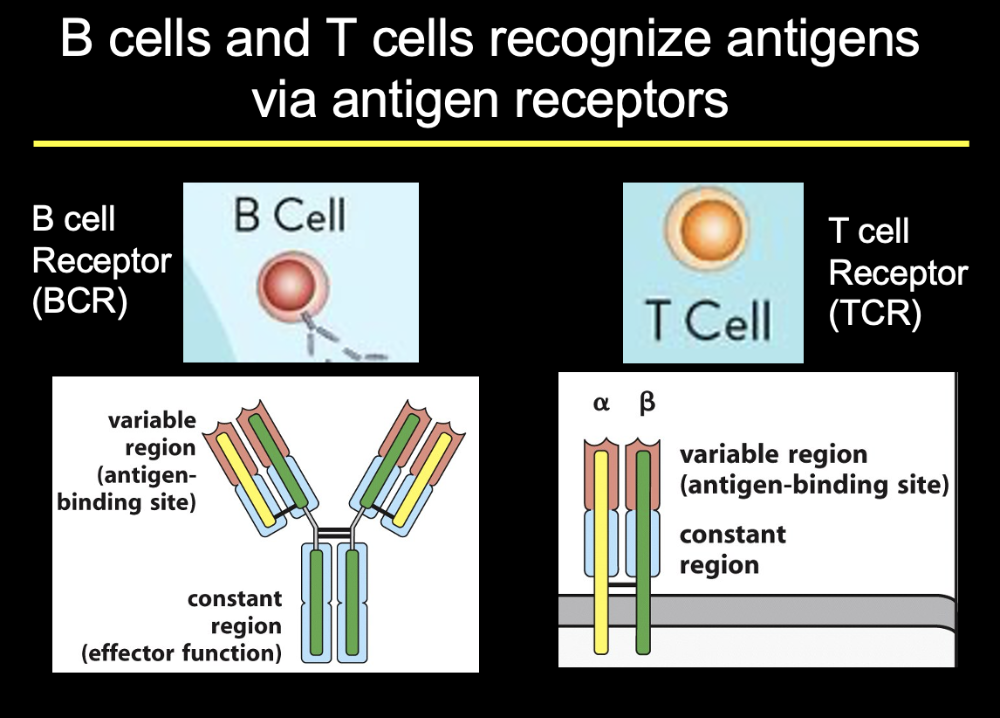
BCR (B cell receptor)
- Y shape (see pic)
TCR (T cell receptor)
- 2 straight parallel lines (see pic)
both have variable region (antigen binding site) and constant region closer to base
Exam question about this stuff?
B cells work by shooting their antibodies
T cell receptors are not effector molecules – it is never secreted even though the T cells are effector cells
antibody is made up of two distinct polypeptides: heavy chain (HC) and light chain (LC)
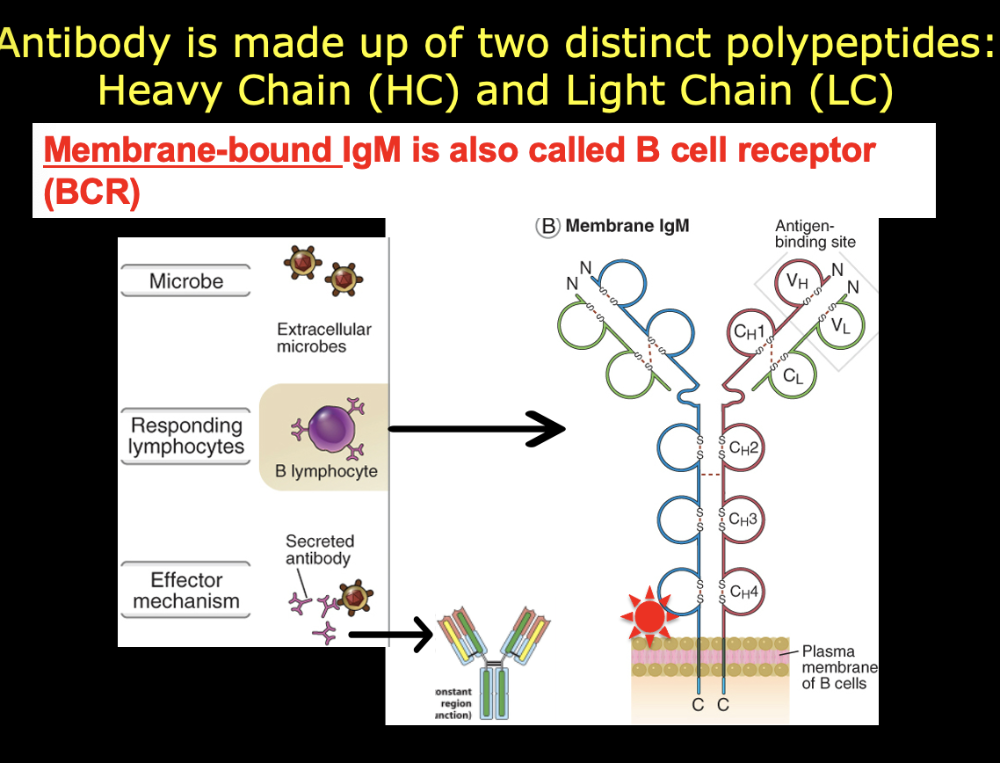
membrane bound IgM is also called B cell receptor (BCR)
membrane bound is the B cell antigen receptor
- sits on surface of B cells
before antibodies come about, how does BCR become an antibody molecule?
- it is not just secreted, there is more to it
- B cell
must be instructed to produce antibody
- antigen binding site send signal into cell whose membrane where this receptor is sitting
properties of antibodies and T cell receptors
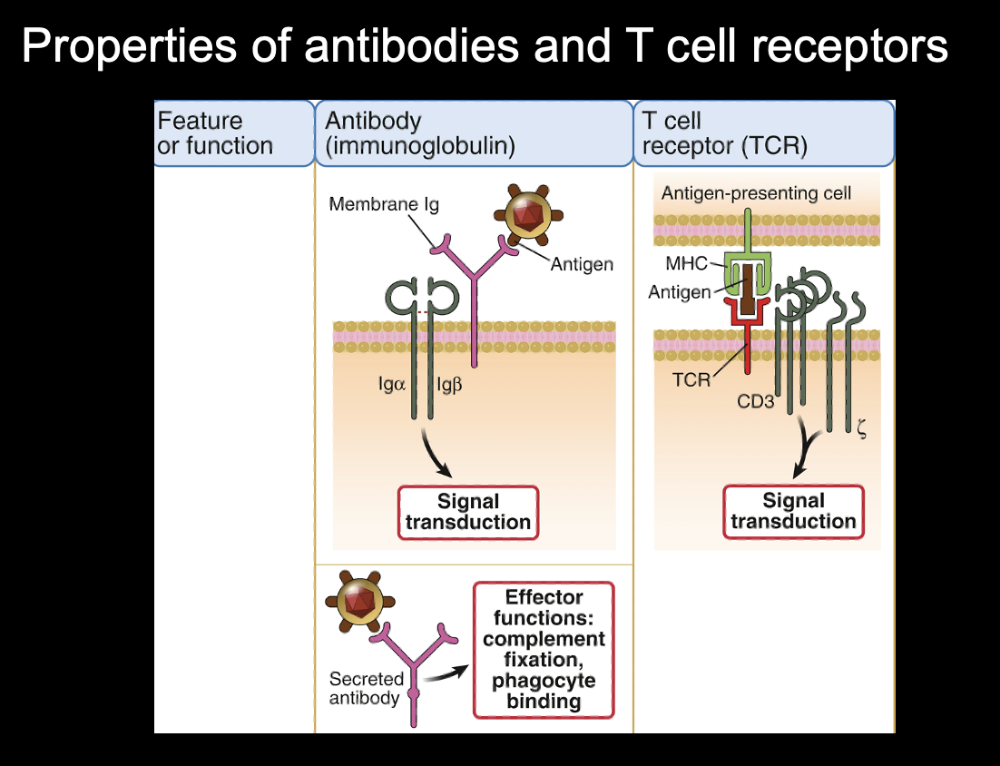
BCR has unique situation
- it itself cannot signal
- associate w/ 2 polypeptide
chains (alpha and beta), which themselves have signaling capability
- signaling depends on associated molecules
- signal
transduction occur via other molecules, BCR or TCR cannot do it
by itself
- when sees antigen, the clones must expand in number so that immune system is effective
- so concept that cell expressing receptor must be triggered to multiply so that immune response is effective
BCR transmits intracellular signaling via associated Iga/Igb proteins
BCR signaling changes the biology of B cell -> activation -> proliferation
- antigen binding brings more than 1 BCR together -> congregation (crosslinked B cell) allows phosphorylation
- motive in associated proteins – they must change in order to get signal to multiply and make millions of cells
- ITAM (the motive) – change in binding site may cause this change inside (but we do not know)
- discovered biochemical changes altered the state of signal transduction in the lymphocyte -> initiate multiplication of the cell to make many B cells that have the binding specificirt of the SAME antigen
Clonal expansion – clone that multiplies but does NOT change its binding specificity (antigen binding site can always bind to same antigen that initiated the activation) (IMPORTANT)
2. Why must antibodies be made as membrane-bound BCRs before they are secreted?
They must be first bound as BCRs because when they interact with the antigen, the signal is sent to the B cell to proliferate and activate, THEN the BCR can be secreted (and now secreted is the antibody)
its important that the interaction occurs while its bound on the membrane as a BCR so the cell recognizes the antigen to activate
the pause for activity questions are sometimes used to make exam questions?
I think he said this
BCR transmits intracellular signals via associated Igalpha and Igbeta proteins
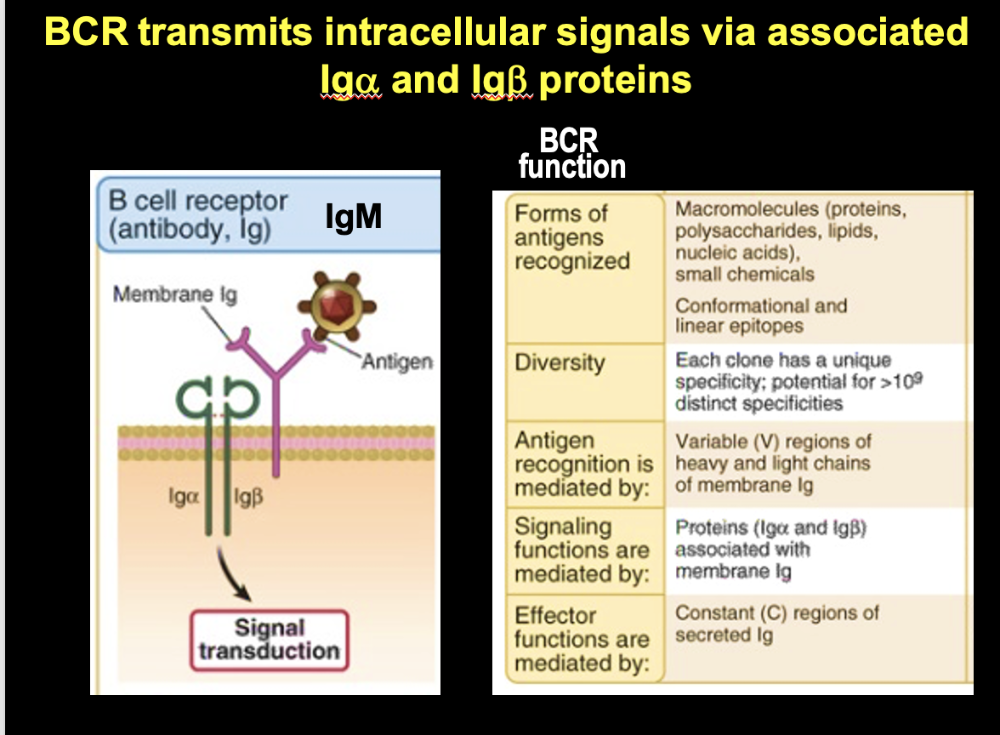
B cell receptor = antibody = Ig
BCR functions
- forms of antigen recognizes
- macromolecules, small chemicals, conformational and linear epitopes
- diversity
- each clone has unique specificity; potential for >10^9 distinct specificities
- antigen
recognition is mediated by:
- variable (V) regions of heavy and light chains of membrane Ig
- signaling
functions are mediated by:
- proteins (Igalpha and Igbeta) associated with membrane Ig
- = signal transduction
- effector functions are mediated by:
- constant (C) regions of secreted Ig
BCR can directly bind to antigen particles, bacteria, viruses
they are highly flexible in terms of what structure they can recognize
- can come from antigen from future alien, would exist already here
- number of B cell clones there are can basically bind to any structure
- ex: as if there are premade ID cards for all
people on earth, as well as ppl who lived in past and will live in
future
- same for immune system
- basically, cells can recognize pretty much anything they come across
flexibility of binding and almost no limit as to what the BCR can bind
- bc can bind proteins, polysaccharides, lipids, etc
B cells see structures, while T cells see proteins, peptides, only amino acid sequence
B cell and T cell antigen binding molecules
(PIC) BCR vs TCR - KNOW THESE IN PIC
antigen recognition thru combination binding - heavy chain and light chain - together form the antibody molecule
- heavy chain + light chain = binding site
many effector functions of antibody once secreted come from the constant region (base/bottom part)
- has functionality - gives antibodies diff functions
- for B cells
- T cells cannot do this - TCR does not perform effector functions
3. What are some similarities and some diffs btw BCR and TCR?
...
there is an antibody for every possible antigen
very important to know this!
Each B cell clone produces a unique ability
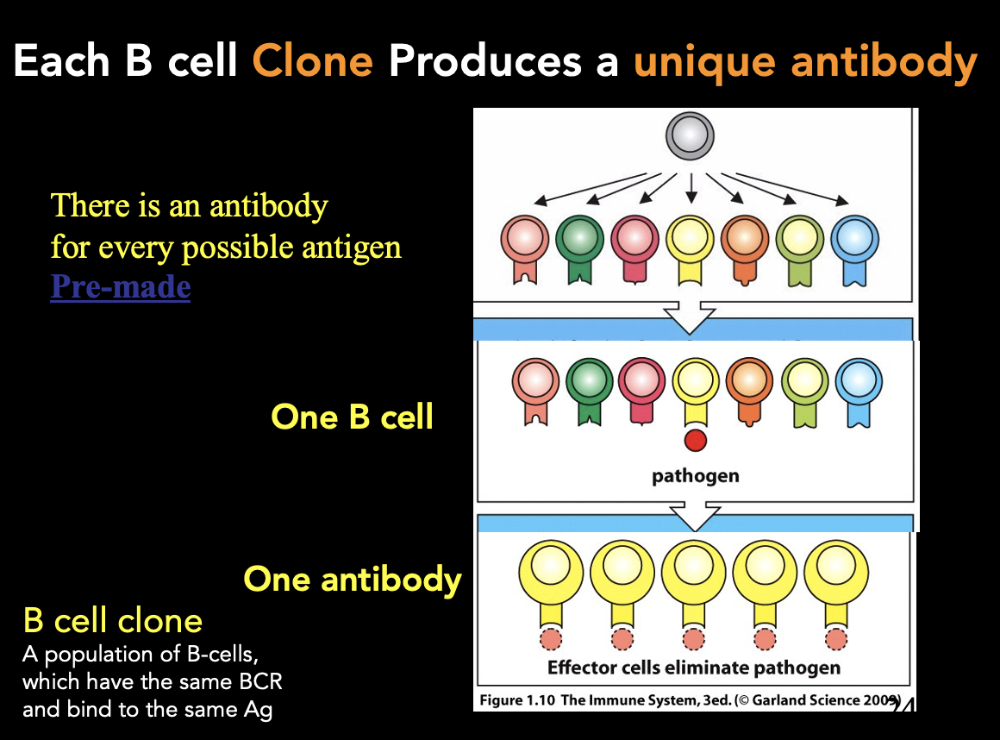
- antibody premade for every possible antigen
When antigen come, will find one of the clones specific for that pathogen/antigen
Ex: yellow recognize the pathogen, multiplies, and then produces the same antibody
- secrete BCR in form of antibody – is the same antibody that each clone is making
How is it possible that there are so many diff clones generated? Will probably address later on
B cell clone - population of B cells which have the same BCR and bind to the same Ag
clonal selection hypothesis
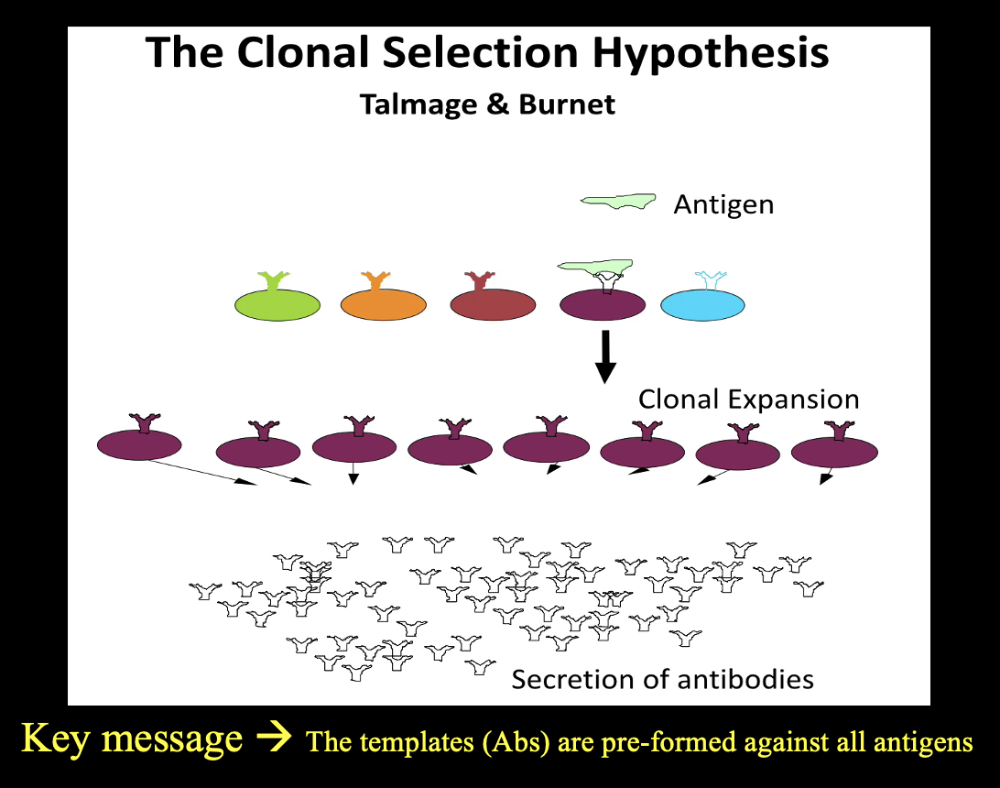
Undergo clonal expansion (only B cell receptor (BCR) undergoes this) -> multiply -> millions of the B cell clone
2000 molecules/second antibodies made
They are everywhere – why they are effective
Efficacy lies in mass number og molecules
Key: antibogies = templates made pre-exposure to pathogen
- clones are premade (existing ID for everyone card analogy)
templates (Abs) pre formed against all antigens
clonal selection upon antigen encounter
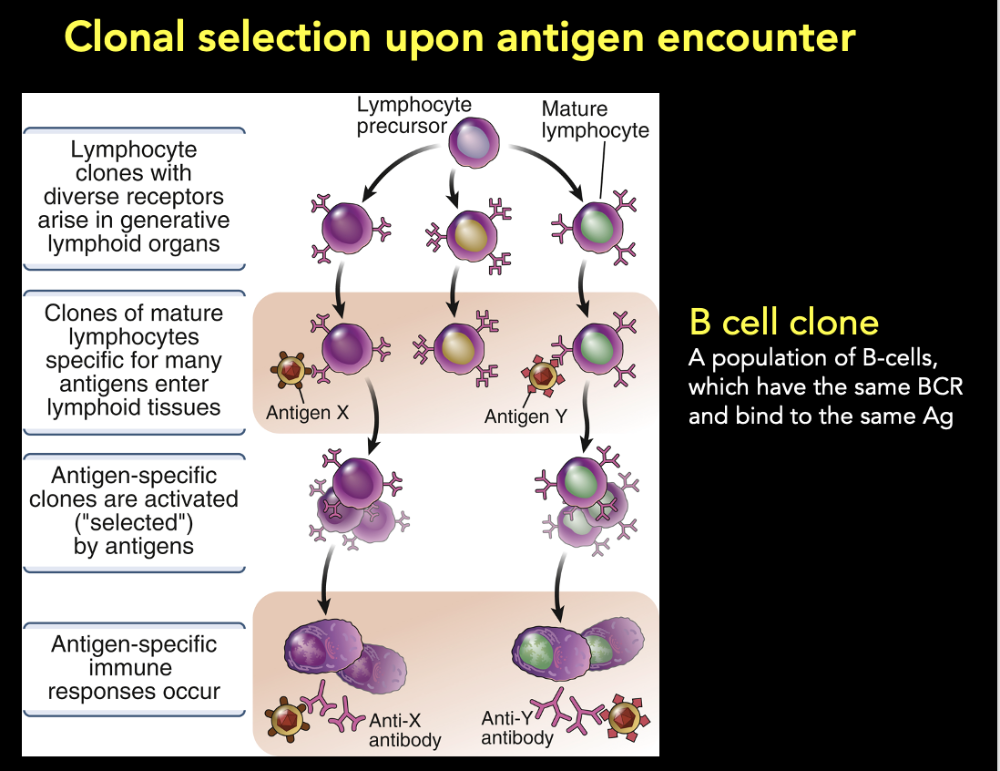
lymphocyte precursor -> mature -> clones of mature lymphocyte for many antigens einter lymphoid tissue -> antigen specific clones are activated my antigens -> antigen specific immune responses occur
Specificity does not change by expansion of numbers
B cell clone - population of B-cells which have the same BCR and bind to the same Ag
4.
A. Why are antigen-specific BCRs made before encountering the
antigens?
B. what is clonal selection?
...
antigen specific B cell clone can be used to produce monoclonal antibody
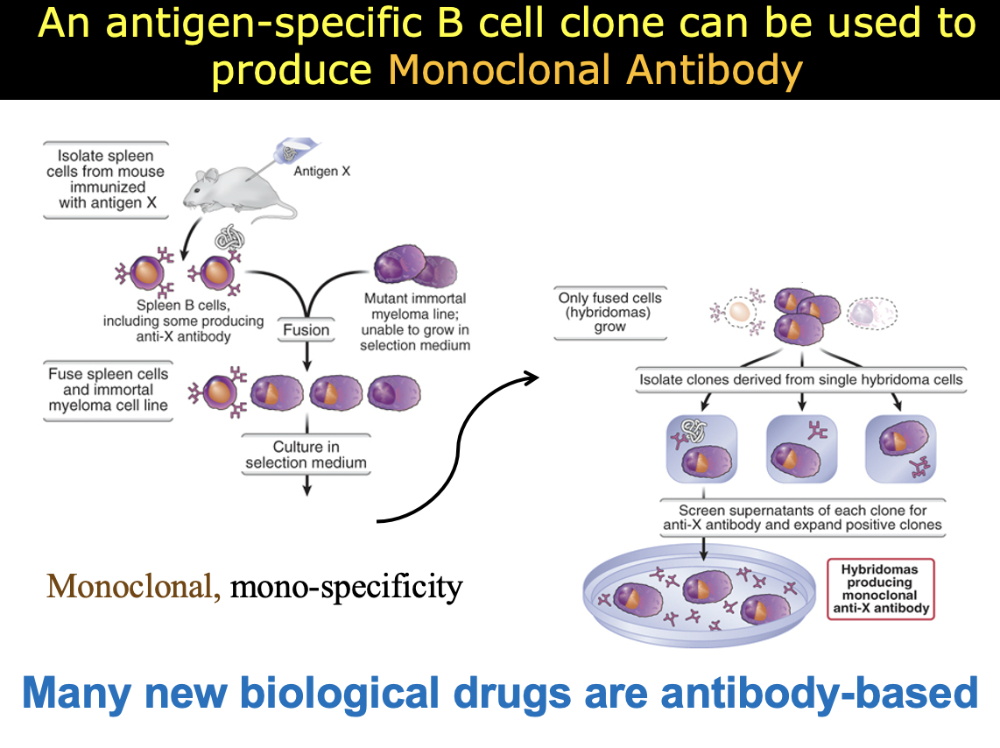
antigen specific B cell clone can be used to produce monoclonal antibody
- isolate spleen cells from mouse immunized w/ antigen X (spleen cells have B cells producing anti-x antibody)
- fuse spleen and immortal myeloma cell line
- cultured in selection medium (where mutant immortal myeloma cannot grow)
- only the fused cells grow
- isolate clones derived from single hybridoma cells
- screen supernatants of each clone for anti-x antibody and expand positive clones
- = hybridomas producing monoclonal anti-x antibody
monoclonal - mono specificity
Antibody can be a drug
- first biological drugs invented
- all biological processes need molecular interactions
- antibodies bind specific structures, bind to them and can prevent interactions
- if certain interaction causes disease, then the interaction is blocked and disease stopped
Ex: cancer cell B cell – specific clone of the antibody lives forever, and makes the antibody you want
- isolate spleenocytes from animal
- mix them w/ cancer cells
= some of the immune cells become immortalized = antigen specific B cell immortalized
-> then continuously make antibodies. Have it proliferate and make many in vitro for drug/therapeutic/medicine purposes
= power of clonal expansion
Clonal expansion of B cells and T cells is extremely important + key for efficacy of adaptive immune system
Have clonal expansion – have millions of cells -> some kept for memory, some become plasma cells and only make antibodies
see take aways
...